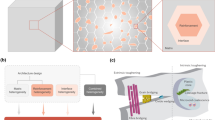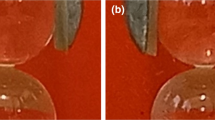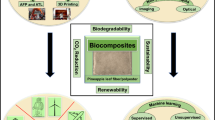Abstract
Cellular materials are widely used in various applications because of their low density and high strength. The mechanical behavior of cellular materials under various loading conditions has been investigated. Nevertheless, many of these previous studies assume that the Young’s modulus of constituting struts is the same in tension and compression. The present work first derives analytical expressions for the effective Young’s moduli of hexagonal and diamond lattices composed of struts with different tension and compression moduli under the assumption of small strain deformation. It also uses the finite element method to further investigate the mechanical responses of these lattices. The macroscopic Young’s moduli under both compressive and tensile loads are reported as a function of the ratio of compression and tension moduli of constituting struts. The numerical finite element models are implemented by a user defined material subroutine in ABAQUS. Results reveal that the effective Young’s moduli of periodic hexagonal and diamond lattices significantly decrease with decreasing ratio of compression and tension moduli of the struts. Furthermore, the mechanical behavior of hexagonal lattices composed of struts with different tension-compression moduli is dependent on the loading direction and whether they are compressed or stretched. The unique mechanical properties of bi-modulus cellular materials could find important applications in the automotive and construction industries.
Similar content being viewed by others
References
L. J. Gibson, M. F. Ashby and B. A. Harley, Cellular Materials in Nature and Medicine, Cambridge University Press (2010).
H. Hatami-Marbini and C. R. Picu, Modeling the mechanics of semiflexible biopolymer networks: Non-affine deformation and presence of long-range correlations, Advances in Soft Matter Mechanics, Springer Berlin Heidelberg: Berlin, Heidelberg (2012) 119–145.
T. A. Schaedler and W. B. Carter, Architected cellular materials, Annual Review of Materials Research, 46 (2016) 187–210.
L. J. Gibson and M. F. Ashby, Cellular Solids: Structure and Properties, Cambridge; New York: Cambridge University Press (1997).
L. J. Gibson, M. F. Ashby, G. Schajer and C. Robertson, The mechanics of two-Dimensional cellular materials, Proceedings of the Royal Society of London. A. Mathematical and Physical Sciences, 382 (1982) 25–42 1782.
A. M. Hayes, A. Wang, B. M. Dempsey and D. L. McDowell, Mechanics of linear cellular alloys, Mechanics of Materials, 36 (2004) 691–713.
A. Bonfanti, S. Syngellakis and A. Bhaskar, Elastoplastic response and recoil of lattice structures under hyperbolic hardening, Journal of Mechanical Science and Technology, 32 (2018) 1667–1675.
Q. Ma, H. Cheng, K.-I. Jang, H. Luan, K.-C. Hwang, J. A. Rogers, Y. Huang and Y. Zhang, A nonlinear mechanics model of bio-inspired hierarchical lattice materials consisting of horseshoe microstructures, Journal of the Mechanics and Physics of Solids, 90 (2016) 179–202.
J. L. Grenestedt, Influence of wavy imperfections in cell walls on elastic stiffness of cellular solids, Journal of the Mechanics and Physics of Solids, 46 (1998) 29–50.
H. Hatami-Marbini and R. C. Picu, An eigenstrain formulation for the prediction of elastic moduli of defective fiber networks, European Journal of Mechanics - A/Solids, 28 (2009) 305–316.
X. E. Guo and L. J. Gibson, Behavior of intact and damaged honeycombs: A finite element study, International Journal of Mechanical Sciences, 41 (1999) 85–105.
K. Ushijima, W. J. Cantwell and D. H. Chen, Effects of inclusion on the in-plane mechanical performance of microlattice structure, Procedia Materials Science, 12 (2016) 100–105.
C. Chen, T. J. Lu and N. A. Fleck, Effect of inclusions and holes on the stiffness and strength of honeycombs, International Journal of Mechanical Sciences, 43 (2001) 487–504.
Q. He, W. Tang, J. Zhang and X. Wang, Effects of concentrated rigid inclusions defects on the in-plane impact behavior of hexagonal honeycombs, Journal of Mechanical Science and Technology, 31 (2017) 4691–4701.
H. X. Zhu, J. R. Hobdell and A. H. Windle, Effects of cell irregularity on the elastic properties of 2D Voronoi honeycombs, Journal of the Mechanics and Physics of Solids, 49 (2001) 857–870.
Q. He, J. Feng, H. Zhou and G. Tian, Numerical study on the dynamic behavior of circular honeycomb structure with concentrated filling inclusions defects, Journal of Mechanical Science and Technology, 32 (2018) 3727–3735.
D. Lim, H. S. Kim, Y. H. Kim, Y. H. Kim and S. Al-Hassani, Stress analysis of two-dimensional cellular materials with thick cell struts, Journal of Mechanical Science and Technology, 22 (2008) 835.
J.-Y. Sun, H.-Q. Zhu, S.-H. Qin, D.-L. Yang and X.-T. He, A review on the research of mechanical problems with different moduli in tension and compression, Journal of Mechanical Science and Technology, 24 (2010) 1845–1854.
Y. Wen-juan and Y. Zhi-ming, Analytical solution for bending beam subject to lateral force with different modulus, Applied Mathematics and Mechanics, 25 (2004) 1107–1117.
B. G. Compton and J. A. Lewis, 3D-Printing of lightweight cellular composites, Advanced Materials, 26 (2014) 5930–5935.
H. Hatami-Marbini, Nonaffine behavior of three-dimensional semiflexible polymer networks, Physical Review E, 93 (2016) 042503.
H. Hatami-Marbini, Scaling properties of three-dimensional random fibre networks, Philosophical Magazine Letters, 96 (2016) 165–174.
Author information
Authors and Affiliations
Corresponding author
Additional information
Recommended by Associate Editor Seunghwa Yang
Hamed Hatami-Marbini is an Associate Professor in the Department of Mechanical and Industrial Engineering, University of Illinois at Chicago, IL, USA. He received his Ph.D. in Mechanical Engineering from Rensselaer Polytechnic Institute and his research interests include computational and experimental mechanics.
Rights and permissions
About this article
Cite this article
Hatami-Marbini, H., Rohanifar, M. Stiffness of bi-modulus hexagonal and diamond honeycombs. J Mech Sci Technol 33, 1703–1709 (2019). https://doi.org/10.1007/s12206-019-0322-1
Received:
Revised:
Accepted:
Published:
Issue Date:
DOI: https://doi.org/10.1007/s12206-019-0322-1




